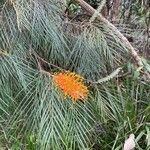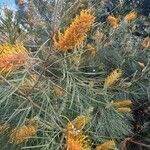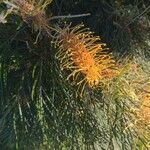A slender tree. It grows 5-8 m high. It spreads 3-7 m wide. The leaves are silvery. The whole leaf is 15-43 cm long and it is divided into narrow lobes. These can be 7-30 cm long by 0.5 cm wide. They are fine. The flowers are bright orange or red. The style sticks out. They are 1.5-3 cm long and are arranged along a long stalk 10-20 cm long. These are produced near the ends of branches. The fruit is a somewhat woody follicle. It is 1.5-2 cm long and 1 cm wide. They occur in dense clusters and contain 2 brown seeds.




